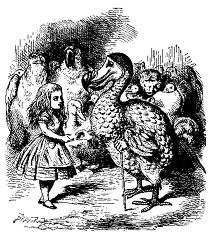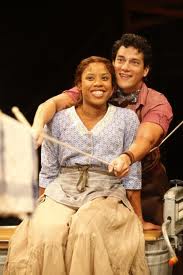“For the past half century and more, it has been generally taken for granted that the director of a film is to be considered its ‘author,’ the individual who is primarily responsible for the film’s total effect, even when the weight of factual evidence pertaining to a specific film clearly indicates otherwise. Yet it remains unusual for the average American filmgoer to be able to name the directors of more than a handful of his favorite movies, and prior to the Fifties, when the ‘auteur theory’ became fashionable, it was far less common. For years, the only Hollywood directors widely known by name were those who, like Charlie Chaplin and Orson Welles, also starred in the films they directed–and a mostly forgotten man named Cecil B. DeMille…”
Archives for November 2010
TT: Just because
Nat King Cole sings “Stompin’ at the Savoy,” accompanied by Roy Eldridge, Coleman Hawkins, Stan Getz, and the Oscar Peterson Trio with Jo Jones on drums:
TT: Memories on the walls
One of the frustrating things about changing apartments on the fly is that Mrs. T and I haven’t had time to hang any of the two-dozen-odd pieces in the Teachout Museum. If you’re serious about it, hanging pictures is an excruciatingly serious business, especially when you have a lot of them, and we’re still in the maybe-this-one-should-go-there stage of what promises to be a protracted process. Hence it’s pleasant to be reminded of what we’re missing, and on Saturday The Wall Street Journal ran a very good interview with one of our favorite artists, Jane Wilson, whose “Breaking Light” (pictured above) is one of our proudest possessions.
We met Wilson in a midtown elevator last year—she’s eighty-six years old and still a beauty—but can’t claim to know her, so it’s nice to find out that she likes to listen to the music of Francis Poulenc while painting, and that she sees her work as being filled with sky and space:
Ms. Wilson starts each new work with a horizontal line near the bottom of the canvas. Not necessarily a bold line, but something she can use to orient herself. “I know I want a lot of sky,” she said. “My subject is really atmosphere and the quality of air as we live it. That’s what I think about: the vitality in surrounding spaces.”
Read the whole piece, then pick up a copy of Elisabeth Sussman’s Jane Wilson: Horizons. You won’t be sorry.
TT: Almanac
“‘Yes, sir,’ said Jeeves in a low, cold voice, as if he had been bitten in the leg by a personal friend.”
P.G. Wodehouse, Carry On, Jeeves
TT: Getting better
 I have much to tell—about our move to Hudson Heights, our trip to Smalltown, U.S.A., and various other adventures along the way—and no time or energy with which to tell it, at least for the moment. Instead I’m busy judging a literary award, which means that I’m winnowing down some thirty-odd books to a short list of half a dozen or so worthy titles. This is fun and no fun at the same time (too many good books, not enough prizes). I also have to finish writing an essay on Cab Calloway and continue the seemingly endless process of unpacking a couple of dozen boxes that all bear labels indicating that they require more or less immediate attention.
I have much to tell—about our move to Hudson Heights, our trip to Smalltown, U.S.A., and various other adventures along the way—and no time or energy with which to tell it, at least for the moment. Instead I’m busy judging a literary award, which means that I’m winnowing down some thirty-odd books to a short list of half a dozen or so worthy titles. This is fun and no fun at the same time (too many good books, not enough prizes). I also have to finish writing an essay on Cab Calloway and continue the seemingly endless process of unpacking a couple of dozen boxes that all bear labels indicating that they require more or less immediate attention.
The good part—there is a good part—is that Mrs. T and I have gotten our new living room into something remotely approaching civilized order. Yes, the bookshelves required a couple of hours’ worth of aggressive sorting, but I supplied it this afternoon, and the room as a whole is now neat enough that it’s already possible to sit and relax without feeling the irresistible compulsion to Do Stuff.
 To be sure, Mrs. T and I have started making preliminary decisions about which works of art should hang where, which should keep us busy for weeks to come. On the other hand, my Nakamichi SoundSpace 5 stereo, which looks not unlike a piece of minimalist sculpture, is already set up in the northwest corner of the room and is emitting beautiful sounds. Tranquility, in other words, is peering through the window from time to time, though it has yet to make itself at home.
To be sure, Mrs. T and I have started making preliminary decisions about which works of art should hang where, which should keep us busy for weeks to come. On the other hand, my Nakamichi SoundSpace 5 stereo, which looks not unlike a piece of minimalist sculpture, is already set up in the northwest corner of the room and is emitting beautiful sounds. Tranquility, in other words, is peering through the window from time to time, though it has yet to make itself at home.
I’ll keep you posted as I continue to pull myself together. For now, suffice it to say that Mrs. T and I are very happy to be here and are feeling exceedingly hopeful!
TT: Almanac
“I’ve found that one must try and teach people that there’s no top limit to disaster—that, so long as breath remains in your body, you’ve got to accept the miseries of life. They will often seem infinite, insupportable. They are part of the human condition.”
Ian Fleming, You Only Live Twice
MP3
Samuel Beckett, Waiting for Godot (Hallmark). You never know until you look. The much-coveted Columbia Masterworks double-LP set of the original 1956 Broadway production of the most influential play of the twentieth century–complete and unabridged–was sneaked into print earlier this year as an mp3-only download. Now you can hear Bert Lahr, E.G. Marshall, Kurt Kasznar, and Alvin Epstein (the last of whom is, glory be, still with us!) performing Samuel Beckett’s masterpiece with supreme, sublime theatricality. No program notes, alas, so to read about how the Herbert Berghof-directed production took shape, read the relevant chapter in Notes on a Cowardly Lion, John Lahr’s wonderful 1969 biography of his father–but do that later. Right now, go straight to your computer, download this album at once, and listen to what the Cowardly Lion made of Estragon. The price? $3.56. Believe me, you’re never going to get a better deal on anything as long as you live (TT).
TT: An O.K. Oklahoma!
In today’s Wall Street Journal drama column I review two shows, one in Washington, D.C. (Arena Stage’s Oklahoma!) and one off Broadway (the world premiere of Neil LaBute’s The Break of Noon). Here’s an excerpt.
* * *
Corny, charming, and as handsomely made as a hand-sewn quilt, “Oklahoma!” is one of the permanent landmarks of American musical theater. Though scholars continue to quarrel over whether the first of the Richard Rodgers-Oscar Hammerstein II collaborations was also the first “integrated” musical–a show, that is, in which music, lyrics, book and choreography all work together to advance an emotionally serious plot–contemporary audiences don’t care whether it deserves priority over, say, “Pal Joey” or “Porgy and Bess.” Either way, they like it fine, and show no signs of longing for some fancy director to treat it to a high-concept staging. Nor has Molly Smith, the artistic director of Arena Stage, done anything of the kind. Ms. Smith’s “Oklahoma!” is a perfectly, almost baldly straightforward production that deviates from the norm in only two ways: It is performed in the round by a multicultural cast whose members include a Latino Curly (Nicholas Rodriguez) and a black Laurey (Eleasha Gamble). Otherwise, this is much the same “Oklahoma!” that your grandfolks loved.
 Is that good enough for 2010 and the inaugural production of the newly built Mead Center for American Theater? Arena Stage’s enthusiastic audiences clearly think so, and up to a point I’m inclined to agree with them. Ms. Smith’s unselfconsciously lively staging, after all, is full of the high-stepping energy without which no production of “Oklahoma!” can hope to make its mark. What I miss, however, is any sense that we’re being told something about the show that we didn’t already know….
Is that good enough for 2010 and the inaugural production of the newly built Mead Center for American Theater? Arena Stage’s enthusiastic audiences clearly think so, and up to a point I’m inclined to agree with them. Ms. Smith’s unselfconsciously lively staging, after all, is full of the high-stepping energy without which no production of “Oklahoma!” can hope to make its mark. What I miss, however, is any sense that we’re being told something about the show that we didn’t already know….
Neil LaBute is back again, and I wish I could say that he’s returned to form after a long, dull stretch. No such luck. “The Break of Noon,” like all of his plays since “Fat Pig,” starts strong, loses steam and drifts all over the road before coasting to a dead stop.
Part of the problem is that Mr. LaBute is seeking this time around to breathe life into a musty plot twist that dates back to Edwardian times: How might the modern world respond to a person who claims that God has spoken to him? In this umpteenth iteration, we get a regular-guy businessman named, predictably enough, John Smith (David Duchovny). The only survivor of a mass murder, John believes that God told him midway through the shootings that “you shall be saved.” The experience transforms him, though not so much as to prevent him from capitalizing on the transformation by selling his story to the media, and for the rest of the evening we watch him interact with a string of skeptics, including his ex-wife (Amanda Peet), a cynical talk-show host (Tracee Chimo) and the detective in charge of his case (John Earl Jelks), all of whom are variously disinclined to take his implausible tale at face value.
As usual with Mr. LaBute, the first scene, a monologue in which John tells what happened on the fatal day, is pointed and powerful, but nothing that happens thereafter is half so fresh…
* * *
Read the whole thing here.
